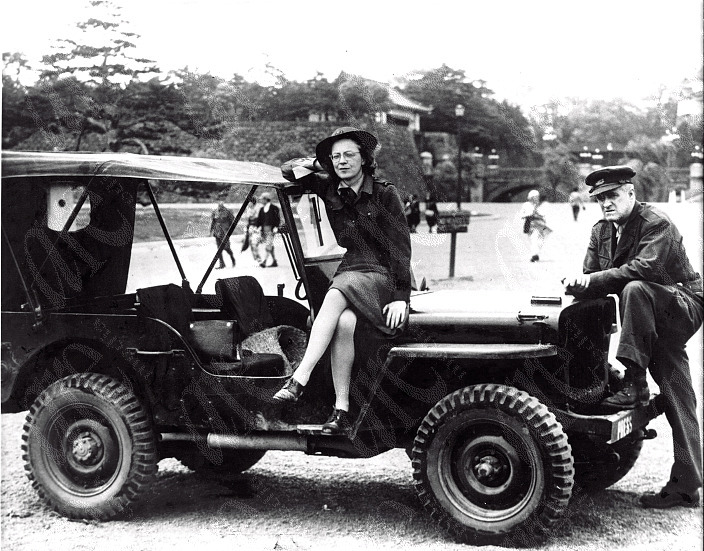About Dorothy Drain
Dorothy Simpson McGregor Drain (1909–1996) was a trailblazer in Australian journalism serving as one of the country’s first female war correspondents. Dorothy worked with the Australian Women’s Weekly for 38 years before retiring as editor in 1975, challenging the status quo and paving the way for future female journalists.
Location
Category
Share and save

Formative years in journalism
Dorothy Drain was born and grew up in Queensland, where her interest in journalism was encouraged by her father. She worked for the Queensland Public Service after leaving school but, finding it uninspiring, left to begin a cadetship with the Brisbane Daily Mail in 1932. She went on to join the Brisbane Telegraph, running the children’s pages and compiling the social news. In 1936 Dorothy relocated to Sydney, taking up a position on the women’s pages of the Sun.
In 1937, Dorothy was recruited to Frank Packer’s Consolidated Press Ltd. Initially assigned to the women’s section of the Daily Telegraph, she moved to the Australian Women’s Weekly in 1938. The Women’s Weekly was already the most popular women’s magazine in Australia and Dorothy stayed there for the rest of her career.
An intrepid war reporter for the Weekly
Dorothy was keen to report first-hand on the Second World War for the Weekly, but Australian Army guidelines made it difficult for female journalists to enter combat zones. Dorothy didn’t let this stop her, travelling to New Guinea even though she was limited to reporting on those involved in supporting the soldiers at the frontline.
In 1946, Dorothy travelled to Japan in the hospital ship Manunda and spent three months in Japan reporting on the Australians serving with the British Commonwealth Occupation Force (BCOF). Dorothy developed strong anti-war views after she visited Hiroshima a year after the atomic bomb was dropped, she wrote in 1950:
‘War is no place for anybody, man or woman, and if humanity cannot find some more sensible way of settling its arguments it doesn’t deserve to survive’.
Later conflicts
Despite her beliefs about war, Dorothy reported for the Women’s Weekly on Australia’s involvement in the Malayan Emergency and the Korean War in 1950. She was accredited as a correspondent for the Korean War by the American military authorities, which allowed her to witness and report on the impact of the war first-hand.
Confronted with a lack of women’s facilities wherever she travelled, Dorothy overcame this obstacle by not eating salty food or drinking more than half a cup of tea at a time. Despite these challenges, she considered her war-time experiences to be her most impactful assignments.
By 1965, when Dorothy reported on the Vietnam War, the acceptance of women in military zones had grown. She was one of the first Australian female journalist to visit the Australian troops serving there, writing regular stories for the Women’s Weekly.
The success of ‘It Seems to Me’ and later career
Dorothy became one of Australia’s best-known journalists through her popular opinion column ‘It Seems to Me’. Published between 1947 and 1963, her column offered a unique perspective on current affairs and ‘drew a large volume of fan mail, much of it from men.’
A highlight of her career came in 1955 when she became one of the few journalists to obtain an exclusive interview with Frank Sinatra during his visit to Australia.
Dorothy became news editor in 1958, working her way up to Weekly’s chief editor in 1972, expanding the magazine’s coverage of social issues and covering ground-breaking topics such as women’s rights, health, and education.
Dorothy’s legacy
Dorothy retired in 1975 after nearly 4 decades with the Weekly. The magazine acknowledged her singular impact, printing ‘she goes into retirement with a reputation few journalists can match, and with the respect and admiration of her staff and colleagues’.[i]
Dorothy died in 1996 after suffering a heart attack. She is remembered as one of Australia’s most outstanding journalists who helped pave the way for the Australian women journalists, editors and war correspondents of today. The enduring success of The Australian Women’s Weekly today is a testament to Dorothy’s lasting legacy.
References and further reading
[1] ’Dorothy Drain retires’, The Australian Women’s Weekly, 2 April 1975, p. 15
<https://trove.nla.gov.au/newspaper/article/43458830>
[2] Dorothy Drain, ‘It seems to me’, Australian Women’s Weekly, 14 October 1950, p. 23.
[3] ’Dorothy Drain retires’, The Australian Women’s Weekly, 2 April 1975, p. 15,
<https://trove.nla.gov.au/newspaper/article/43458830>
'Curiosity: Stories of those who report during wartime', Anzac Portal, https://anzacporttal.dva.gov.au/resources/courisotiy-stories-those-who-report-during-wartime
'Society nominates home of Dorothy Drain for a Blue Plaque, The Glebe Society, https://glebesociety.org.au/society-nominates-home-of-dorothy-drain-for-a-blue-plaque/
